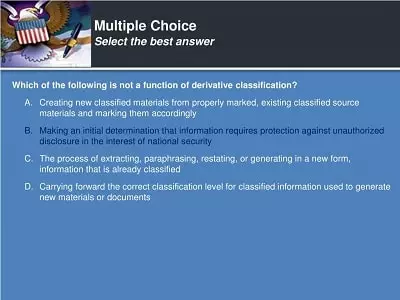The steps in derivative classification are Generating, Paraphrasing, and Restating. These three steps are all important and should be followed as closely as possible. You should also maintain a list of the sources that were used to make your original classification decision. This information does not have to be transferred.
Paraphrasing
Before reproducing or paraphrasing classified information, you must consult the
appropriate official of the originating agency or office. It is also important to follow
the Department’s classification guidelines and properly mark derivative information.
Use the “Classified By” line to specify the name of the derivative classifier.
Derivative classification is the process of incorporating or restating classified information into new forms. Although it is possible to use other sources of information to create derivatives, you must always respect the classification decision of the original classification authority. This means using only authorized sources in determining the classification level.
The primary source of the information used for derivative classification is the Security Classification Guide. The derivative classifier should always keep a list of sources. However, you do not need to transfer the reasons behind the original classification decision. As long as you follow the classification guidelines, you can create a derivative that is free from errors.
Restating
If you’re working on a derivative classification, you may have questions about how to proceed. The first step in the process is to find out who the original classification authority is. The original classification authority can be the president, the vice president, the head of an agency, or someone else who has been designated by the President in the Federal Register. Once you’ve identified your original classification authority, the next step is to determine the level of the derivative.
A derivative classifier must evaluate a material based on the classification guide to determine if it contains information that is classified. This means that the derivative document should meet the classification criteria of the Security Classification Guide (SCG) or the Classified Document (DD-254). However, it is important to remember that material that is not marked classified is not necessarily unclassified.
Another step in derivative classification is determining the need for protection. The classification authority should determine whether the information is necessary to protect and determine the level of protection needed. If the information is not needed to be protected, then the derivative classification must not be performed. For example, a derivative classification cannot involve photocopying classified material.
In order to ensure that a derivative classification is performed correctly, it should be performed by cleared personnel who generate the material. If this is not possible, there is no specific delegation of authority. The person performing the derivative classification has the primary responsibility for the quality of the document. In addition, he or she must respect the classification determinations made by the original classification authority and must take appropriate action if the derivative classification is inaccurate or unsatisfactory.
Generating
Generating derivative classification results is a valuable method for analyzing the dynamics of a system. The method works by generating a derivative of a time series at each time point. This yields the class label for that time. This approach reduces the spatiotemporal classification problem significantly. It also improves the interpretation and analysis of derivative time series.
The process starts with identifying the sources of the material to be classified. The information must fit within the classification guidelines. It is also illegal to derivatively classify information that is more than 25 years old. In addition, derivative classification of information is not allowed for information that might reveal the identity of a human intelligence source or a confidential human source. In addition, derivative classifiers must identify themselves by their personal identifier or position.
Derivative classification of a document is a crucial step in determining the classification level of a document. It is crucial to follow appropriate procedures to achieve accurate results. A derivative classification should also include any markings from the original classification authority. The source document must also be marked to reflect its classification, reason for classification, and instructions for downgrading or declassification. The markings must be clear and prominent.
The derivative classification process can involve different techniques. The first method involves using the existing classified information and creating a new document based on it. The resulting material must bear the same classification markings as the source material. Before derivative classification is applied, DoD and contractor personnel must receive initial derivative classification training.
They must also undergo refresher training at least every two years. If a derivative classification is challenged, it can be suspended or revoked. If a challenge is filed, the challenger has 120 days to get a full response.


